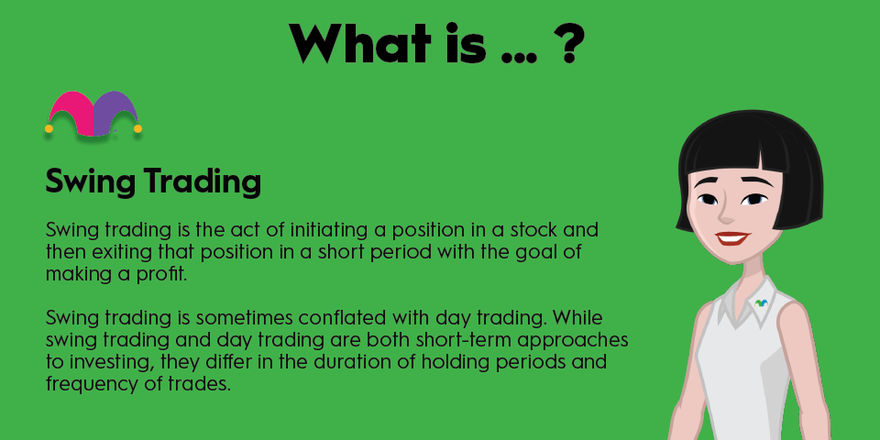Owning stocks can be one of the best ways to generate wealth over time and let your money work for you, but not all approaches to investing are the same. If you’re interested in investing, you may have heard of swing trading and might be wondering if this approach to stocks is a worthwhile way to make money.

What is it?
What is swing trading?
Swing trading is the act of initiating a position in a stock and then exiting that position in a short period with the goal of making a profit. Swing trading may involve either buying the stock in hopes that it will go up and can be sold at a profit, or selling it short with the expectation that the share price will go down and the position can be covered for a positive return.
Swing trading is sometimes conflated with day trading. While swing trading and day trading are both short-term approaches to investing, they differ in the duration of holding periods and frequency of trades. As the name suggests, day trading involves buying and selling stocks based on movements that happen within a single daily trading session. Swing trading typically involves holding or shorting stocks for multiple days or weeks before exiting the position.
What investors need to know
What investors need to know about swing trading
Swing traders often use technical analysis to gauge whether a stock is likely to go up or down. Technical analysis is an approach to predicting stock movements that uses pricing chart trends, patterns, historical pricing ranges, trading volume, and other elements. As an example, swing traders might look at the number of orders made for a company’s stock at a certain price to determine how much support there is for it at that price, and then decide to either buy or short the stock.
In some cases, swing traders may also rely on fundamental analysis or make trades around upcoming performance updates or other expected news. For example, a swing trader might buy a company’s stock ahead of an upcoming earnings report with the expectation that the results will push shares higher -- opening the door for a quick sale and profit.
Should you swing trade?
Should you swing trade?
It is possible to achieve strong results with swing trading. This short-term approach to investing has become more popular among some investors now that most leading brokerages offer commission-free trades, but it remains very risky. Although positive returns can be generated with swing trading, and the prospect of quick gains may be appealing, this approach to investing can also open you up to painful losses or lead to missing long-term opportunities.
Pricing chart patterns, buy-and-sell orders, trading volume, and other data points may provide investors with information that can be used to inform winning strategies, but there are simply too many unknown variables involved in a stock’s short-term pricing movements to make this kind of strategy a sure thing. Momentum for the broader market may push a company’s share price in the opposite direction of suggestions made by technical analysis. Unexpected news also might be released that shapes stock performance.
In most cases, you probably shouldn’t engage in swing trading unless you are open to outsized risk. Predicting what will happen with the broader market and individual stocks over short intervals is incredibly difficult and almost impossible to do with a high level of consistency. For most investors, taking a buy-and-hold approach that focuses on finding strong companies that are worth owning for the long haul is a much better path to seeing strong gains in the market.
Example
An example of swing trading
Through the years, Alphabet’s (GOOG 9.96%)(GOOGL 10.22%) stock has seen some dramatic pricing fluctuations. If an investor noticed that the company’s share price had been pushed down to a level that looked low based on where it had been trading over the last year, he or she might begin to be interested in the stock as a potential swing trade.
After deciding that a large volume of offers to buy the stock slightly below its current share price suggested strong support at the current valuation, the investor plans to invest in Alphabet with the thesis that it’s likely to bounce above current levels within the next week. If catalysts push the company’s share price up, the investor will have the opportunity to sell the stock at a higher price and score a nice return in a short period of time. On the other hand, if negative news for the company or bearish pressures for the broader market emerges, the company’s stock could quickly be pushed below the investor’s purchase price – even though technical analysis had suggested there was support at that level.




































































































